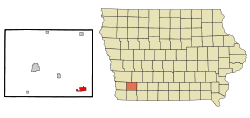Villisca, Iowa
| Villisca, Iowa | |
|---|---|
| City | |
 |
|
| Nickname(s): V-Town | |
 Location of Villisca, Iowa |
|
| Coordinates: 40°55′45″N 94°58′41″W / 40.92917°N 94.97806°WCoordinates: 40°55′45″N 94°58′41″W / 40.92917°N 94.97806°W | |
| Country |
|
| State |
|
| County | Montgomery |
| Area | |
| • Total | 1.90 sq mi (4.92 km2) |
| • Land | 1.90 sq mi (4.92 km2) |
| • Water | 0 sq mi (0 km2) |
| Elevation | 1,076 ft (328 m) |
| Population (2010) | |
| • Total | 1,252 |
| • Estimate (2012) | 1,230 |
| • Density | 658.9/sq mi (254.4/km2) |
| Time zone | Central (CST) (UTC-6) |
| • Summer (DST) | CDT (UTC-5) |
| ZIP code | 50864 |
| Area code(s) | 712 Exchange: 826 |
| FIPS code | 19-80985 |
| GNIS feature ID | 0462574 |
Villisca is a city in Montgomery County, Iowa, United States. The population was 1,252 at the 2010 census. It is most notable for the unsolved axe mass murder that took place in the town during the summer of 1912.
Villisca is located at 40°55′45″N 94°58′41″W / 40.92917°N 94.97806°W (40.929115, -94.978162).
According to the United States Census Bureau, the city has a total area of 1.90 square miles (4.92 km2), all of it land.
As of the census of 2010, there were 1,252 people, 525 households, and 331 families residing in the city. The population density was 658.9 inhabitants per square mile (254.4/km2). There were 614 housing units at an average density of 323.2 per square mile (124.8/km2). The racial makeup of the city was 97.4% White, 0.2% African American, 0.9% Native American, 0.2% Asian, 0.2% Pacific Islander, 0.6% from other races, and 0.5% from two or more races. Hispanic or Latino of any race were 3.0% of the population.
...
Wikipedia
